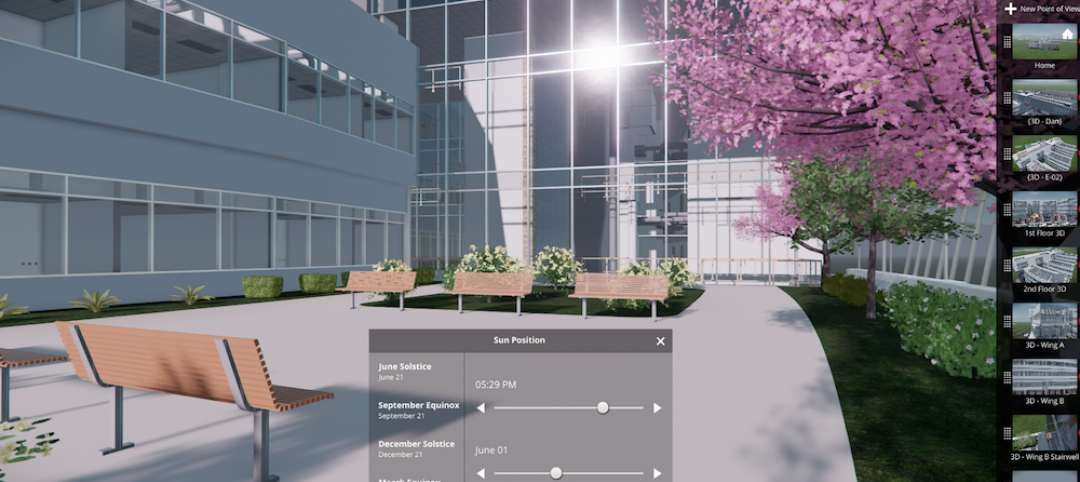
Collaboration software is going beyond just sharing files. It is being used to enable full building information modeling early in design. Two programs are enabling Building Teams to more easily share the information in BIM and use it for integrated project delivery: Bluebeam Software, which just released the newest version of its AEC-specific PDF collaboration tool; and eBuilder Enterprise, a Web-based capital project and program management tool used by owners and real estate professionals.
PDF Revu 8: beyond PDF markup to file management
Architects and contractors have been using paperless tools such as Bluebeam PDF Revu for much of the past decade. Over its first seven previous versions Bluebeam has evolved from a PDF creation tool born in the aerospace industry to one of the most popular PDF markup and revision tools in the AEC market.
The company's latest release, Bluebeam PDF Revu 8 (CAD edition), is moving beyond digitizing paper to full project collaboration and management. It features Microsoft SharePoint and Bentley ProjectWise integration and a new file manager that lets users search, “pin,” and integrate their documents with other users' systems. The new version also has a Revit plug-in that can integrate it with Revu.
“We don't speak in terms of being a PDF editor anymore,” Bluebeam CEO Richard Lee told me. “We're really focused on providing workflow and collaboration software. You will see in the future a lot of functionality and features designed around how people work. The fact that it is in PDF is just convenient.”

The most noticeable change in Revu 8 is a new “file access tab” on the left panel of the user interface. It allows mouse-over preview of any PDF and shows the location of the file, whether it's on your hard drive or in a shared project management program such as SharePoint. The access tab's history area gives a quick view of all of the PDF files you looked at recently.
“Users told us, 'I want to be able to get to the PDFs I work with quickly, whether they're on a SharePoint drive or on my machine,'” said Don Jacob, VP of engineering at Bluebeam. “Our mid-size to large AEC users want better integration.”
The SharePoint integration offers an easy connection to files in the document management platform. A new explorer panel, similar to Windows Explorer, is embedded in the file access tab in Revu 8. From that panel you can automatically navigate the SharePoint library and check files in and out without having to switch between Bluebeam and SharePoint.
You can also check version histories of files in the library from the explorer and “pin” them to projects and documents on your hard drive. The functionality seems to work similarly for ProjectWise, but I couldn't try that one out, as I was unable to obtain a review copy of ProjectWise.
The “pinning” feature, itself is a new addition that addresses a major pain point many architects and contractors have when managing project files: keeping them together and organized. With two mouse clicks you can pin any file and it will stay in your access tab (with a pushpin designating its file as such) with all of its history information available to you on mouse-over. You can pin files to a project or a group of projects.

The tool sets are also improved in Revu 8. Some of the new markup tools include representations of people (good for scale) and welding markups for fabrication drawings. The personal toolbar in Revu 8 is more customizable, too, allowing you to add any Revu 8 function to it. This is good for companies that use one toolbar layout for architects, a different one for engineers, and even more customized layouts for super-users.
Finally, one of the smallest but best additions to Revu 8 is hyperlinking within annotations for fabrication drawings. Many subcontractors and fabricators bemoan the lack of reference documentation in computer-generated shop drawings. How can you access “Appendix 6” when all you've been given is “page 300?” By adding actions to an annotation, anyone who has page 300 automatically also receives a hyperlink to Appendix 6 in Revu 8. In the war against paper-based workflows, it's the small victories such as this that will carry the day for paperless.
E-Builder: Integrated for project management
E-Builder Enterprise is a Web-based project and program management application that helps facility owners and operators—and the AEC companies that provide services to them—address the challenges associated with the planning, design, construction, and operation of complex capital projects.
E-Builder clients are primarily facility owners with ongoing capital programs (e.g., additions, renovations, new facilities), such as Inova Health System. All that users need to use the system is a browser, username, and password, and it can be accessed anywhere via the Web. Some of the core aspects of the system include cost control, schedule management, change management, and construction administration.
“The entire e-Builder system is SAS 70 Type II certified,” said Jonathan Antevy, CEO of e-Builder. “It's a significant on-going investment but it has become the standard that our clients demand of us.” Antevy says that his company has been developing Web based software-as-a-service (SaaS) since its founding in 1995. “Our business is not built for a specific platform like Windows or Mac,” he says. “It is built for the Internet.””=
Duke University Health System in Durham, N.C., is currently using eBuilder on the 600,000-sf, $559 million addition to the Duke Medicine Pavilion. The project, which started rolling in 2009, will add 160 critical care ICU stepdown beds and 16 new operating rooms to the pavilion. The addition has been designed to achieve LEED Silver certification.
“We did a one-way integration of all of the financial information for the project from our SAP system into e-Builder,” said Mark Greenspan, director of facility planning, design, and construction at Duke Medical Center. “Our accounting departments tracks overall costs in the SAP system, but our project managers needed that information at a more granular level. It was fairly simple to get that information imported from SAP into e-Builder in the format we could use.”
Another eBuilder project is the Advanced Health Sciences Pavilion at Cedars-Sinai Medical Center in Los Angeles, an 800,000-sf, $400 million new hospital that is integrating e-Builder's tools with the Solomon accounting system.
Project managers at Cedars-Sinai—which broke ground last summer and is expected to be completed in 2012—use e-Builder to check monthly audit reconciliations, as well as for budgeting, archival processing, and storage of construction documents and meeting minutes.
“We needed our information more directly available to us,” said Robert Cull, executive project director for facilities planning, design and construction at Cedars-Sinai.
Both of these projects are using BIM files cataloged in e-Builder Enterprise. E-Builder supports BIM review by allowing users to work with BIM files without third-party software via an integrated Autodesk Navisworks viewer. You can upload a BIM file into e-Builder published to the .NWD file format, which includes all loaded models, the scene's environment, the current view, and favorite viewpoints, so that you can view the file and its animation without Navisworks or another translator.
“The changes that someone on a project makes cause other changes that we can control and automate with our process and workflow tools, ” Antevy said. “We give our clients the ability to focus on process instead of technology.”
Related Stories
BIM and Information Technology | Sep 7, 2016
Energy Star Portfolio Manager tool updated to factor in waste management
The costs and benefits of managing 29 types of waste are now included.
BIM and Information Technology | Aug 30, 2016
BIM GIANTS: A ranking of the nation's top BIM design and construction firms
HOK, Perkins+Will, Turner Construction Co., The Whiting-Turner Contracting Co., Jacobs, and Thornton Tomasetti top Building Design+Construction’s annual ranking of the nation’s largest BIM AEC firms, as reported in the 2016 Giants 300 Report.
BIM and Information Technology | Aug 30, 2016
New service from CBRE provides deeper insights into in-building wireless network experiences
With dependable cellular and Wi-Fi coverage a must-have amenity for today’s businesses, CBRE to certify in-building network quality through new Cellular Signal Mapping service
BIM and Information Technology | Aug 22, 2016
The wicked problem of interoperability
Building professionals are often put in a situation where solving problems with the ‘best tool for the job’ comes at the cost of not being able to fully leverage data downstream without limitation, writes Proving Ground's Nathan Miller.
Contractors | Aug 10, 2016
Dodge launches new app to simplify pros' search for suitable projects to bid and work on
The product, called PlanRoom, could be particularly useful in sharing data and communications among AEC teams.
BIM and Information Technology | Aug 9, 2016
How to improve a project presentation with animated GIFs
Animated GIFs are a simple tool that can explain a large amount of intricate information in an easy to understand, streamlined manner.
BIM and Information Technology | Jul 25, 2016
Autodesk’s LIVE turns designs into video game-like experiences
Users can adjust navigation points, render styles, and even the time of day, with fluid and quick controls.
Building Tech | Jul 14, 2016
Delegates attending political conventions shouldn’t need to ask ‘Can you hear me now?’
Each venue is equipped with DAS technology that extends the building’s wireless coverage.
BIM and Information Technology | Jun 14, 2016
Autodesk and Trimble will share APIs to develop products that improve user workflow
Data and document management is likely to benefit the soonest.
BIM and Information Technology | Jun 13, 2016
The race to digitize the globe with 3D imagery
Tech firms are creating a highly-detailed virtual planet available instantly for those who would like to scrutinize it. SmithGroupJJR's Stephen Conschafter details the new technologies being used to map our world.
















